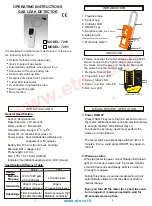
E2632
Rev 17.05.2021
The terminals on the E2632 series devices are suitable for a wide range of wires with
cross-section 0,2...1,5 mm
2
. We recommend to strip the wire end by 5...6 mm and use the
wire end sleeves. To connect the wire, loosen the screw, insert the wire end into the
terminal hole and tighten the screw.
To use relay outputs, connect the chosen actuators to the relay terminals RE1 and/or RE2
for each sensor.
NOTE! Actuator short-circuits shall be avoided, to protect the instrument relays, use
external fuses or safety switches.
3. Place the lid back and fix it with the screws. Make certain that the cable glands are
properly tightened to ensure the conformity to IP65 protection class.
4. Turn on the power. It may take up to five minutes after switching on for the sensor to
stabilize.
For stable operating, it is recommended to keep the detector powered constantly, except
for periods of maintenance and calibration, replacement, etc.
Operation
During the first ca. 60 seconds after powering on E2632 performs a warming-up and
self-diagnostic routine, indicated by the flashing of each LED. Each sensor has two LEDs.
The upper dual-color LED remains continuously green in normal operation and blinks red in
case of device or sensor fault. The warm-up time depends on the sensor types, unpowered
period, and atmosphere.
During the first 30 seconds after powering on you may select the automatic or manual
mode of alarm release. Touch the device with the magnet key on the bottom of the device.
A short touch (< 2 s) enables the automatic mode, a touch of 2...10 s — manual mode. The
activation of the automatic mode is followed by a single LED blinking and acoustic signal.
If manual mode is activated, the double acoustic and light signal follows.
9





























